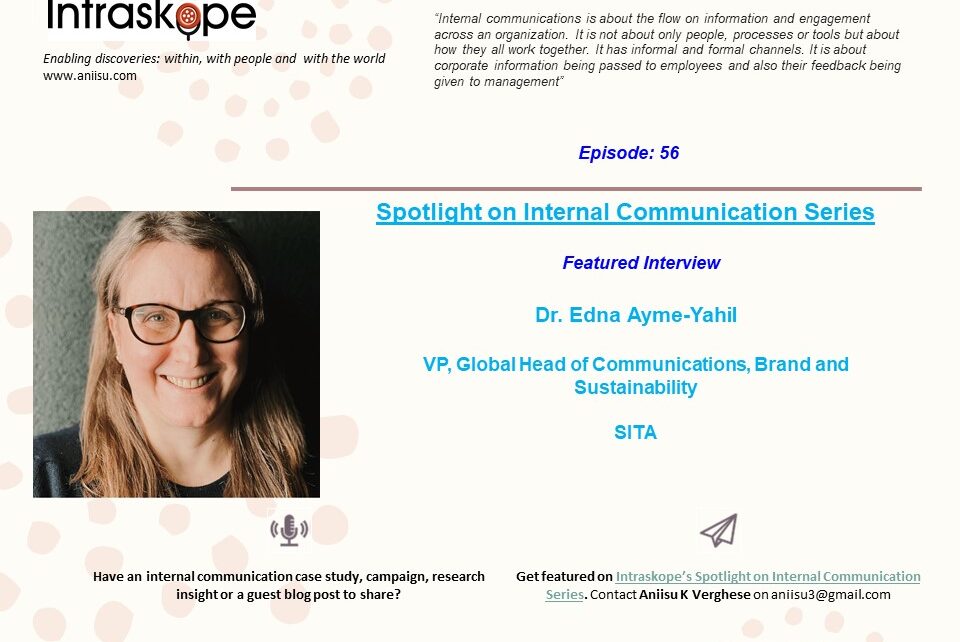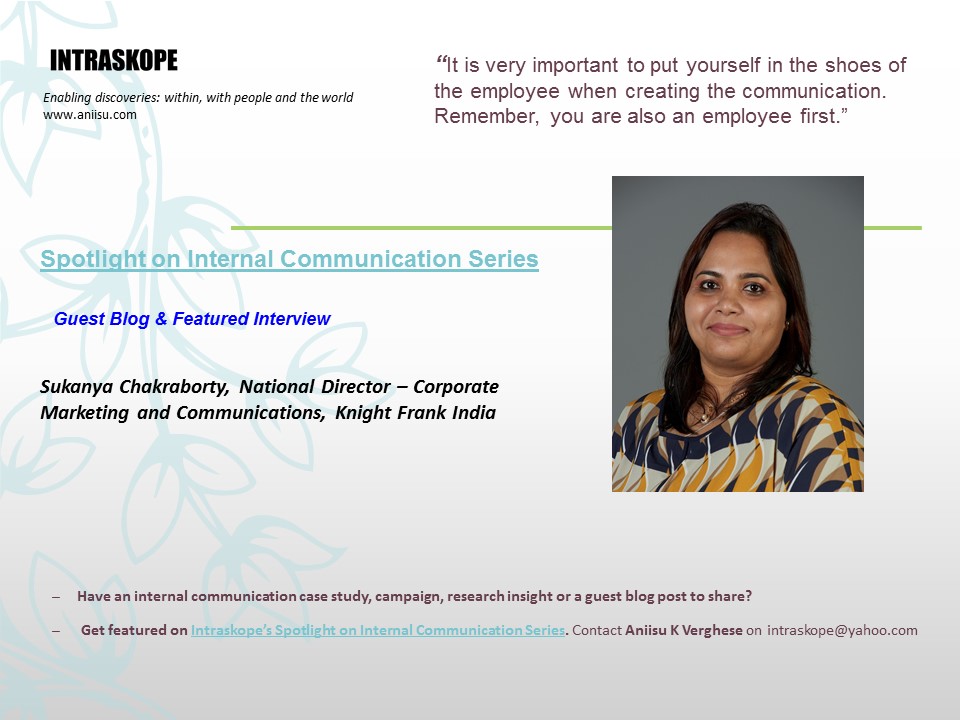Presenting the 56th edition of Intraskope’s Spotlight on Internal Communication Series featuring Dr. Edna Ayme-Yahil, Head – Communications, Brand and Sustainability at SITA. Dr. Edna is the founder of DigiComms (www.communications.digital), a strategic marketing and communications agency. In her previous in-house role, she served as the SVP and Head of Marketing and Communications at Panalpina. She is a former board member and former managing VP for the European Association of Communications Directors. Dr. Edna has held various global marketing and communications roles at Nissan, STMicroelectronics, Philip Morris International, EIT Digital and UNESCO and was a consultant for the OECD. She has also taught communications and history at the University of California Los Angeles, University of Arkansas, University of Paris, and Washington State University. She graduated from Stanford University, studied at the École normale supérieure, and holds a doctorate from the University of California, Los Angeles. Dr. Edna is based in Geneva, Switzerland.
In this interview, Dr. Edna pitches for internal communications and the influence it can wield if given the attention and investment it deserves. She believes there is greater appreciation for internal communications although there is a lot which needs to be done to continue the momentum and build on the respect gained. She provides insights on gaining confidence of stakeholders and investing in skills that can improve how internal communicators can add more value to the business and beyond.
Watch the complete video interview on YouTube or read the transcript below.
Interview
- What does internal communication mean to you?
Internal communications is about the flow on information and engagement across an organization. It is not about only people, processes or tools but about how they all work together. It has informal and formal channels. It is about corporate information being passed to employees and also their feedback being given to management. in the past few years, the field has become much more developed a lot more thinking about academic and by practitioners. And we see that they’re, they’re both the formal and the informal channels. So, it’s no longer about the intranet, the town hall, etc. It’s just much more than that. And, and it’s also just about flow. So, it is about corporate information to employees and how was their feedback going back up to management to the CEO, or even to the board.
2. Please share an example/campaign that you are personally proud of working on and that made a significant impact to an organization in the recent past.
I will share two. The first is about the Coronavirus in response at Sita for me professionally, as well as for my peers. I’m involved with a lot of groups with other people who are heads of communication especially in in in Europe and my remit is much larger than just internal communications. But the amount of time I spent on internal communications this year was a greater percentage wise than it would be and I don’t think that’s changing. I think there’s a new kind of appreciation for that but let me go to the recent past meaning pre-Covid time. I joined Sita right when lockdown happened in March 2020. Before that, I was in Panalpina which is in Basel and was one of the top five logistics freight forwarders. They were bought over. At Panalpina, we put together a fantastic campaign called the Panalpina Spirit. And it was really linked to the values to the vision, the mission, and the campaign was done with employees, by employees using employee models. We created a joint narrative with the employees of the company, and then enabled employees to sort of tell their story about the long, rich history of the company. And I think those types of strategic projects that are linked to the company’s purpose and vision are the ones that that really are a long lasting and really, meaningful.
Sita is a very special organization. Let me just give a little background before I go into the details. We are present in almost 160 countries we have employees who are in certain major sites but also servicing airports primarily. And so, what we do in in Sita is we have a framework for internal communications, but we have several different channels that we use. So, first and foremost, we have our top leadership – the 140-150 people mostly reporting into the Executive Committee, and they’re called our evolved leaders. Evolve is part of a transformation program and we have a special program which is sponsored by the CEO, which works to inform these leaders to train them. There is a leadership course in partnership with IMD. And so, we depend on these leaders to help communicate within the organization. So that’s one thing. The second aspect is that we do have direct communication from the CEO through regular calls with managers and all staff calls, which we hold once a quarter and then we have a really neat program, which I inherited. called the location leaders program. One of the unique things that Sita is that often employees’ managers will be in another country. So the location leader is someone who is usually the most senior person at a major locations of Geneva, Atlanta, Dubai, Singapore, etc. They have a day job, so this is something they do in addition. They work in partnership with the country HR, and they run a program that has a lot of employee engagement for people who are in that location. This became extremely useful during COVID and the pandemic because a lot of the shutdowns back to work, regulations, etc. especially when you change from country to country. We ended up relying much more on this location leader community to do the internal communication. My team manages also that community – we have a monthly call with them, we prepare material, etc. We obviously have an intranet which is quite robust. We have a newsletter that we send every other week from corporate – which collects and curates, key information from internal and external and pushes that out. And those are the basic channels. We also have a lot of special programs that we’ve put in place linked to Coronavirus. So, obviously, there’s the work from home. When we first went into lockdown, we had to make sure that everyone had a computer and is accessible. I mean it was it was it was quite complicated. And I think we move from that sort of panic mode and I would say in March 2020 into really starting to realize we’re going to be here for a long time. We need to over communicate; we need to also start to offer well-being opportunities for people. Often this is done location by location and it’s everything from digital yoga and in Ireland, they had a very famous of cook give a cooking class for everyone and the team might have occasionally had cocktails on Friday afternoon. We tried to put in place some programs and also even you know when we would have our staff calls and spend more time on wellness well-being and how people were responding rather than only give updates on the business. It’s been it’s been interesting to put it mildly.
3. What is the biggest challenge you face while going about managing internal communication?
I think the biggest challenge is that in some organizations, internal communications is considered the ugly stepchild of external communications. And that’s a reality. It’s wrong. Often you can have more measurable impact doing internal communications than you can doing external communications. So, I think that’s the opportunity, especially as a young professional, is that often in internal communications, we have closer access to business strategy and to the senior leadership than you might when you’re sort of like, the person writing the press release, I’m exaggerating a bit. And so, I think that that that for the individual communicator, having an internal communication role for a few years or longer is a wonderful opportunity to be close to senior leadership to really truly understand the business. Also, to influence stakeholders in a positive manner. One that is quick to have results as opposed to when you’re doing, a public affairs campaign that can take years to change legislation. So, I think there’s a lot more personal satisfaction that can come in a role like this.
4. What according to you is the biggest opportunity that internal communicators have?
To be really close to senior leadership and understand the business and then influence many stakeholders in a positive manner
5. How can internal communicators add more value to the business?
Well, I think the key is to be closely linked to the business and speak the language of the business. And there’s several things that need to need to happen. I think one is it’s important to put in place especially if you’re dealing corporate wise or regionalized, programs with clear identification of the “what” you’re offering. I am offering as an internal communicator, for example, to help build communication capacity in your team. I’m not writing your emails for you, but I will train your people how to do that. So that’s what I’m offering to also put in place – the right toolkits and processes so that people can help themselves and know what to do right. And to really focus on adding value as an internal communicator. And it takes a lot more to step back and put in place a program where you can see measurable feedback, but also know how to sort of push back to the demands that are unreasonable. The days of creating the odd presentation or putting posters is finished. I think the other thing that is happening, which has changed since I started doing internal communications several years ago, is that I think HR is getting more involved in employee engagement. And so I think there’s a lot of opportunity to really partner with HR either on the change management side on the employee engagement or even in the talent acquisition side, which is sort of borderline between employee communications. I think there’s room to partner, but the key for me is be linked to the business. Do what the business wants and use business vocabulary – EPS, EBITDA etc to speak the language of your customer.
6. What skills must they have or develop?
I believe the following skills are important:
- Communication Strategy – a structured planning activity that considers the internal and external environment, business needs, research, audience, stakeholders, key messages, communication channels and measurement.
- Content Writing/Messaging–define, create and deliver key messages:
- Channels and Tactics (Distribution)-identify, manage and effectively use a variety of channels and tactics to deliver messages:
- Research, Analysis and Measurement –use research to inform and refine their practices and measure the outcome of their strategies. To do so they must demonstrate effectiveness in:
- Business Knowledge – understand and analyze the organizational operating environment against the communication challenges and opportunities:
- Stakeholder Engagement – identify, collaborate and nurture stakeholder relationships. To do so they must demonstrate effectiveness in:
7. What is your advice for people who are keen to join internal communication and make a career?
I completed a program with my HR business partner at Sita, where we did was we mapped out the competencies for the whole marketing and communications. We went around to all of our different geographies. We got input from an external provider and we really put in place a framework for Sita but I think it’s adaptable for other people. It starts off for me with the communication strategy. That means you have a structured planned activity and we have an editorial calendar for the whole company. And then each of the geographies in each of the business units at corporate feeds into that. We have regular meetings. With management, we have quarterly meetings where we talk really strategy with the heads of the regions or the business units. We have monthly meetings, and then with everyone we have a weekly meeting where we really go through what’s being done and we and we share so that strategy and then executing off. On the first day, it is about writing and messaging, how do you define create and deliver key messages across different channels. When I see people who sort of get stuck in a glass ceiling often the skill that’s missing is the writing. So that’s something you’ve really need to work on early in your career.
I think channels and tactics is something people need to understand and manage effectively and in a smart way and they’re constantly new ones and you really need to continue to learn and see what’s available and what you want to do and also what people are using on the outside. A lot of companies want to use Yammer, right and no offence to Microsoft, but it’s not the same experience that you have on tick tock right. So, your employees want to have a similar experience communicating internally. I think research analysis and measurement is key. Impactful research don’t have a deck of 50 slides for management to really show. With a few key KPIs you can show how you’re making an impact on the business.
I think business knowledge, business savvy, really understanding finance, operations, supply chain sustainability. These are key to understanding and to make yourself effective. Finally, it’s the relationship with your customers with your internal stakeholders, and you need to be able to be effective but also to you know, to say No. And saying No, is sometimes harder than saying Yes.
8. What is your advice for women who want to make a mark in this domain and what must they do differently?
I think the biggest advice I give youngsters is – what’s your end game? First you get out of university, you want a job? Yeah, I have a job, okay. But then you need to start to think where do I want to be in five years, 10 years etc. Now, you can have a beautiful career, your whole life in internal communications, and especially if you’re a change management practitioner, etc. You can, move into consulting or corporate but it should be a choice, right? And if you want to have a job like me, which is head of communications, – I was doing internal communications, I would say from about 2009 to about 2015 exclusively, and then I made a conscious decision that I wanted a broader job, And I think its where I see people seeing regret is they get to a certain age, and they’ve been in internal comms their whole life because they never made an attempt. Don’t be stuck there because, someone else wants press experience or something. So, I think I think it’s really being conscious of what’s happening in the future enjoying the present but constantly, positioning yourself, for women. I think, the key for me, and I say this, with a bit of regret is that the career is a marathon, not a sprint.
9. With COVID-19 and other crises, how must internal communications engage? What has changed or will change? Examples of how your organization has helped reassure employees and navigate the crisis as it unfolds.
There is a lot of videos, zoom, zoom fatigue, there are all kinds of words that have entered into our vocabulary. I think the challenge now, assuming that that we were going back in certain markets and other markets, we hope to go back soon. Is that hybrid work is here to stay. And how do you create? And there always been companies that are fully remote. And there are companies where people were there full time, but how do you create an environment where you’re able to communicate with people who are physically present but also not there? How do you not discriminate against people who may be working remotely because they have older parents or kids or live further away? You will they have the same career opportunities, etc. So I think I think that the trick in the coming days, with COVID, everyone was at home. And the trick now is really, how do you focus and work around communication so that you really can be inclusive for everyone? I do not have an answer. It’s really complicated. There are also certain markets where we’re certain industries where people are less interested in in going back to the office, then there are other jobs like being a Nurse where you have to be physically there. So, I think, I think this is a space that’s fascinating, and we need to continue to look at for quite some time.
10. Can you share one trend that you spot with internal communications?
So for sure, do it yourself videos. And for a long time there’s become less and less if you will formal within the corporate communications internally. It is not corporate speaking to the employees, but I think now, what we see is, with most employees, having smartphones with people knowing how to do different things, I think, do it yourself video is a very positive trend. It’s important. For example, our brand team also has worked on helping people who are doing their own videos, make them on brand, etc, even on the phone, which I think is useful. If you really want to get into kind of geeky, cool, cool trends. Its using avatar and mixed reality. There’s a lot of fun stuff. Very techie stuff that’s available now, that was just too expensive in the past to do for internal comms and now it’s a lot easier.
11. If there is one aspect of internal communications you would like to change, what would that be?
I think what I would like to change is the perception that it’s less than the external because it’s not it’s just as important if not more important.
Liked the interview? Post your comments and share it with your network.
Keen to contribute and participate in the ongoing series on Intraskope where we put the spotlight on thought leadership, great ideas, and practical solutions?
Look up the previous stories from organizations featured on the Intraskope’s Spotlight on Internal Communication Series here – Northern Trust, AXA Business Services, Subex, global insurer, Standard Chartered Bank, BASF, Applied Materials India, Microsoft UK, Times Group, Samsung, Falabella, Cisco, Brillio, UAE Exchange, Apeland, M.H. Alshaya Co, Proctor & Gamble, Infosys, SOBHA Ltd., ICICI Securities, First Advantage, CK Birla Group, TVS Motors, GE, Suzlon, Tata Sons, Percept, Knight Frank, TCS Europe, Vedanta, Oxfam, Danske Bank, Diageo, Pandora, Symantec, ISS Global Services, Telia, Thomson Reuters, IBM, General Motors, Intelligence India Software Solutions, Philips, Refinitiv, Mastercard, VFS Global, Ittiam Systems, Bridgestone India, Indian automotive company, Uber, L&T Metro Rail Hyderabad Limited, Microsoft India, Hitachi Rail, OYO, Alfa Laval and BD.
Intraskope (www.aniisu.com) is the first blog on internal communications in India and among the earliest around the globe. Begun in 2006, the blog has over 1000 posts on topics such as employee engagement, leadership communication and employee branding and receives thousands of visits from across the world. The blog, receives over 1,50,000 visits every month from over 50 countries globally, offers learning resources for practitioners, academicians, and students including industry workshops, research reports, and checklists.
Intraskope has been featured on leading global internal communication forums like Simply-Communicate, IC Kollectif and International Association of Business Communicators. It is hosted by Aniisu K Verghese, author of Internal Communications – Insights, Practices & Models (Sage, 2012).
If you are an internal communication leader working in a firm or a not-for-profit anywhere in the world and have an internal communication case study, campaign, research insight or a guest blog post to share please contact me on [email protected]
Here are Internal Communications resources you can use:
- Learn: Internal Communications Fundamentals Course on Thinkific
- Internal Communications Series: https://forms.gle/KcqmPzLwq7NQi5Km6
- Chat with Aniisu – Internal Communications: https://www.instamojo.com/intraskope/connect-with-aniisu-60-minute-personalized-d/?ref=store
- Internal Communications workshops: https://bit.ly/2zdBRl1
You can also visit my website www.intraskope.com and You Tube channel to know more about my work.
#respect #seatattable #transparent #open #authenticity #listening #internalcommskills #skilling #ICskills #internalcomms #genuine #internalcommunications #employeeexperience #covid19 #covid19comms #HR #people #process #tools #training #communicationsstrategy #businessunderstanding #writing #chanels #ICtactics



